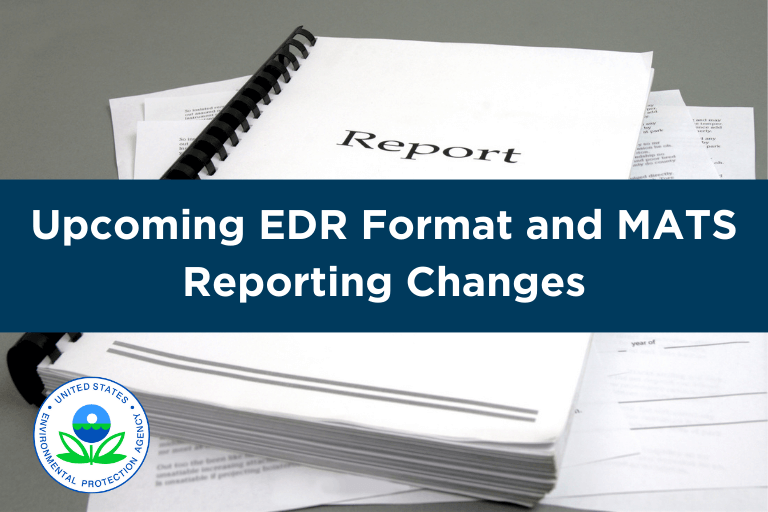Upcoming EDR Format and MATS Reporting Changes
Starting on January 1, 2024, all facilities that currently use the ECMPS tool to evaluate and submit EDR (Electronic Data Records) files will need to switch to the replacement tool, currently called ECMPS 2.0. You can read more about the re-engineering effort here and new reporting instructions here.
Beta Testing and ECMPS 2.0
In December 2021, the Clean Air Market Division (CAMD) opened a beta testing site to demonstrate the new ECMPS 2.0 tool and how it handles Monitoring Plan records. During 2023, the agency will add individual quality assurance tests for beta testing. Only JSON-formatted files will be processed and evaluated in the new tool. The new tool is also expected to be set up to process and evaluate emission JSON format files. CAMD strongly recommends facilities begin using the beta site to evaluate the newly generated JSON formatted files when a Data Acquisition System (DAS) has been updated to generate these new file types.
New Reporting Instructions for Monitoring Plans, Quality Assurance Certification, and Emission Data
In December 2022, CAMD released updated reporting instructions for the three types of files (Monitoring Plan, Quality Assurance and Certification, and Emission data) submitted using the ECMPS tool. These changes reflect the switch from the XML to JSON (JavaScript Object Notation) file format. ESC Spectrum’s DAS applications, StackVision and Prism, need to be updated to accept and import JSON-formatted Monitoring Plan records generated by ECMPS 2.0. Both systems will be upgraded in 2023 to allow these applications to generate JSON-formatted Quality Assurance and Certification and Emission files for evaluation and submission by the new tool.
CEM Systems for MATS Requirements
Facilities using CEMS for MATS (Mercury and Air Toxics Standard) compliance reporting (such as PM, HCl, HF, sorbent traps, etc.) will need to begin reporting Quality Assurance activities. These include Cylinder Gas Audits (CGAs), Absolute Correlation Audits (ACAs), and Sample Volume Audits (SVAs) electronically, to name a few. In addition, compliance reports will be included in the quarterly Quality Assurance (QA) electronic files for the first time, listing the appropriate 30- or 90-day averages, plus other supporting records.
While the changes found in these new reporting instructions primarily focus on the electronic reporting of MATS records, there are a number of small clarification changes in each of the reporting instructions.
Therefore, it is strongly recommended that each facility that currently uses ECMPS review these new reporting instructions to ensure an understanding of the changes that may be needed in Monitoring Plan records or in the QA or emission files.
How Can ESC Spectrum Support Your Transition Through These Changes?
Our Reporting experts are standing by to help correctly record facility data and ensure your reports meet ever-changing requirements for final submission.
If you have any questions about how to navigate your reporting requirements, our Regulatory Services team is standing by to assist you.
Our blog, The Source, holds many resources for reporting tips, including Resubmitting Data to ECMPS, ECMPS 2.0 Re-Engineering Update, and How to Avoid Errors With the Right ECMPS Evaluation Selections.


